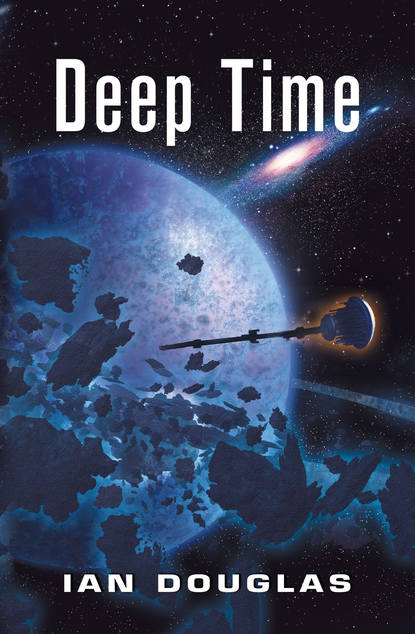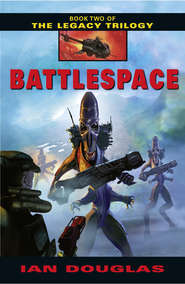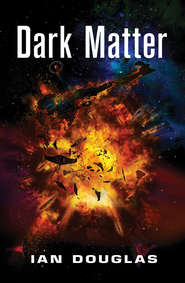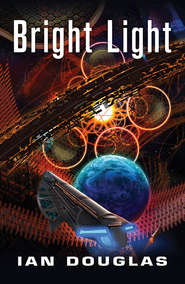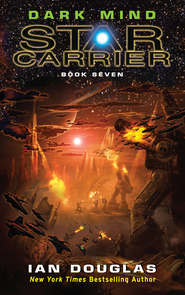По всем вопросам обращайтесь на: info@litportal.ru
(©) 2003-2025.
✖
Deep Time
Настройки чтения
Размер шрифта
Высота строк
Поля
“We have available a potentially devastating weapon in the VLA. We can use that.”
Dahlquist was pleased with himself for thinking of it. The Vesta linear accelerator was the mining facility’s magnetic launcher. They could use it as a monstrous cannon to disable or destroy the alien from here, a full AU away.
“With respect, sir,” Ames said, shaking her head, “it won’t work.”
“No?”
“Not even close. Check the numbers, sir.”
He did so, pulling down stats from Concord’s AI on the mining accelerator and applying the TDA formula, then scowling as the answer came through. At its very best, the one-kilometer magnetic rail gun, accelerating a one-ton payload at twenty thousand gravities down its one-kilometer length, would boost the package to twenty kps—a respectable velocity across interplanetary distances that would cross one astronomical unit in … shit! Just over eighty-six days. It was amazing. Even with all of his training and experience, it was still so damnably possible to underestimate the sheer vastness of space.
And Ames was right. He could be making a hell of a lot of trouble for himself by disregarding those orders … and a Prim like Gray wasn’t worth landing himself a court-martial.
The realization steadied Dahlquist, and helped resolve the issue a bit in his mind. He’d not been aware of just how jealous he’d been of Gray’s advancement up the career ladder, but he recognized it now as her thought about the possibility of crashing and burning over an Article 92. He and Gray were about the same age, with roughly the same time-in-service. Yet he was just a commander, struggling to make captain, while the damned Prim had had his four admiral’s stars handed to him on a plate. There was scuttlebutt to the effect that Gray had friends in very high places; his former commanding officer was now president of the United States of North America. And those friends could cause Dahlquist a lot of trouble.
It wasn’t fucking fair.
He rather neatly disregarded the hypocrisy of a Ristie being jealous of a Prim’s “advantages.”
“Okay, Amesie,” he said. “Take us out. Rendezvous course with Charlie One.”
“Aye, aye, Captain.”
He heard Concord’s communications officer requesting departure clearance, heard the clearance being given by the AI that ran the mining facility. Ceres, a rugged, splotched, and cratered sphere over five huindred kilometers through, dwindled away into the distance, lost among the stars almost instantly. Contrary to popular belief—and countless docuinteractives and in-head sims with a very bad sense of scale—the asteroids were not so thickly sown through the belt that they formed any kind of obstacle. At the moment, exactly one other asteroid was naked-eye visible from Vesta—a fifth-magnitude speck of light a million kilometers away. The Asteroid Belt was very nearly as empty as the rest of interplanetary space.
Dahlquist was embarrassed by the gaffe of suggesting that they use the VLA to bombard the alien ship. Years of chasing rocks, he thought, must have contributed to acute hardening of the cerebral cortex.
He would have to find some way of recovering from the gaffe, or Ames and the members of Concord’s crew would be spreading the story on their next visit Earthside.
Besides that, though, he was also seething from being shown up, not only by Ames, but—in his head at least—by the Prim.
There had to be a way for him to prove himself, as someone brilliant instead of an idiot …
VFA-96, Black Demons
In pursuit
0120 hours, TFT
The problem—as was always the case at relativistic speeds—was one of energy. Every kilogram of mass moving at this speed carried more energy than a fifty-megaton nuclear warhead—the size of the titanic “Tsar Bomba” detonated by the then Soviet Union in the early 1960s. Firing nuclear antiship warheads at the enemy might have unpredictable effects … especially when you realized that the artificial singularities serving as gravitic drives were created and fed by extremely large amounts of energy of their own, drawn from the quantum foam. Add more energy, in an uncontrolled rush, and well …
Connor was not at all anxious to try the experiment.
Instead, she’d elected to try something more subtle: launching one of her battlespace drones as a missile.
Her consciousness was filled by the magnified image of Charlie One, an enormous, organic form of curves and flowing shapes; the twelve accompanying Todtadler fighters were dwarfed by the giant starship. How, Connor wondered, had the aliens gotten that thing past Earth’s defenses and down to the planet itself?
She’d fed specific instructions into the drone’s pocket-sized AI; the relativistic time dilation at this speed was just too sharp to allow precise control. Right now, for every four seconds that passed, over a minute slipped by in the outside universe, and the spacetime fabric around each of the fast-moving vehicles—Charlie One, her own Starblade, and the drone—was distorted enough to scramble data packets and affect fine, long-range control signals.
Closer, now. Charlie One was a few hundred kilometers ahead, though her AI had magnified the image so that it felt like she was just a few meters from the alien’s hull. The twelve fighters appeared to be drawing off now. Connor couldn’t know for sure, but she had the feeling they were getting clear in anticipation of the alien switching over into its equivalent of Alcubierre Drive.
Closer still …
The drone shuddered violently as it passed the gravitic bow wave. Ships under gravitic acceleration projected a field around themselves, a kind of bubble within which mass fell toward the on-off flickers of the projected singularity ahead of the craft’s prow. Hitting the interface between normal space and the space within that highly warped bubble could be like hitting a solid wall.
The image from her drone flickered, broke into static, and vanished.
Connor could only hope that her instructions to the device had been both complete and comprehensive.
Chapter Five (#ulink_e6b8e0e6-dd77-5c14-9383-5ee8613dc660)
29 June, 2425
USNS/HGF Concord
4-Vesta
0128 hours, TFT
With Charlie One having already passed the closest point to Vesta on its outbound trajectory, Concord could no longer move to block the alien’s path. She could start chasing the other ship, however … or, more specifically, she could start accelerating toward the point far ahead of Charlie One where the alien should be when Concord intercepted it.
An intercept would be possible, of course, only if Concord could pile on a little more acceleration. Fortunately, while High Guard cutters weren’t armed to the teeth, they were designed with high-velocity intercepts in mind. An asteroid flung into a dinosaur-killer trajectory by unpleasant aliens might well have a considerable velocity once the course change had been discovered, and the sooner the ship could rendezvous with the incoming rock, the easier it would be to nudge it once more onto a safer course. Concord was a Lexington-class WPS-100 cutter, streamlined to reduce the drag that became significant at relativistic velocities within the dust-filled volume of the Sol System. She would be able to catch Charlie One in another hour—unless, of course, the alien flipped over into metaspace.
Regardless, she would make the rendezvous before the star carrier America.
Back home, in New New York, Dahlquist had a dog—a genetically modified pocket mastiff named Bumble who had a psychotic tendency to chase aircars when they passed overhead.
Like Bumble, Dahlquist wondered what he was going to do with Charlie if he actually caught the thing.
VFA-96, Black Demons
In pursuit
0131 hours, TFT
Connor was flying blind. Her scanners still showed the alien craft about five hundred kilometers up ahead with AI-resolved magnification enough to show some detail, but she wasn’t getting any signal at all from the drone, which minutes earlier had dropped into Charlie One’s pocket of intensely warped space. The device should be falling forward along the alien’s hull, now, in free fall toward the intense, flickering point of projected gravity out ahead of the alien’s nose … assuming, of course, that the alien’s flight technology worked along the same line as that of human ships. Everything she’d seen suggested that the technology was the same, right down to an apparent upper level of acceleration.
The escorting fighters had worked well clear of the alien and were decelerating now. Connor and the other three Starblades were already past them. Possibly, they were deploying to engage the Hawes and the Elliot, which still were following in the fighters’ wakes, but that wasn’t her concern.
She needed to stay focused on Charlie One.
Her Starblade shuddered, and an inner awareness—her link with the fighter’s AI—warned her of trouble: gravity waves. Powerful gravity waves. Her fighter literally was passing through ripples in spacetime.
And then Charlie One was tumbling, its power plant dead, its acceleration at zero.
“Got him!” Connor yelled over the tactical channel. Communications between squadron members were always a bit iffy at relativistic speeds, but she got an immediate acknowledgement from Commander Mackey. Still accelerating, Connor’s fighter closed with the alien very swiftly now, passing it within a hundred kilometers. There was no response from the vehicle, and no indication that she was being tracked or targeted. There was power being generated on board, she noted, but the main power plant appeared to be off-line.
Good. Flipping her fighter end for end, she began decelerating. Rendezvousing with Charlie was going to be touch and go, since the alien spacecraft was still coasting along at very close to the speed of light. But with its singularity drive switched off, it was no longer accelerating, and that made the problem a little bit simpler.





